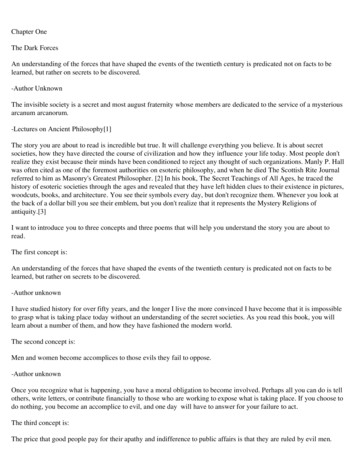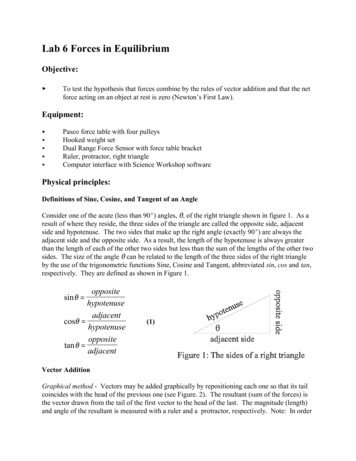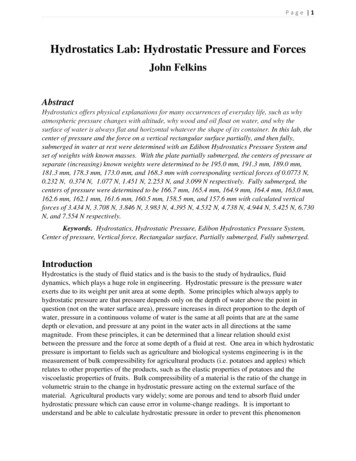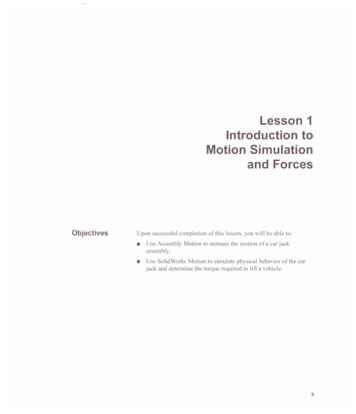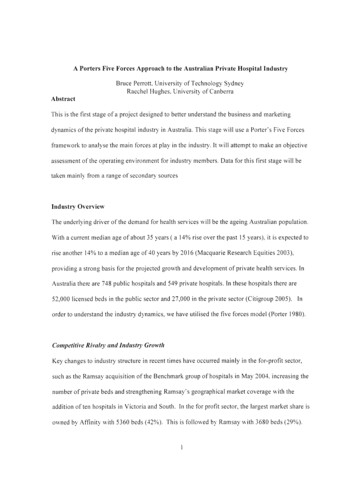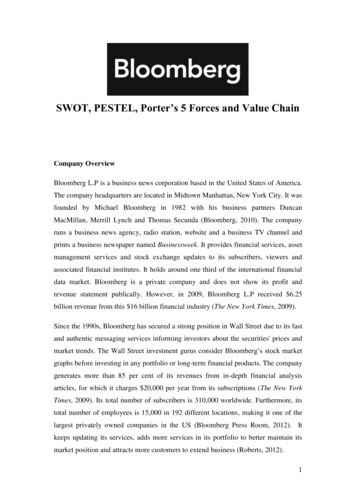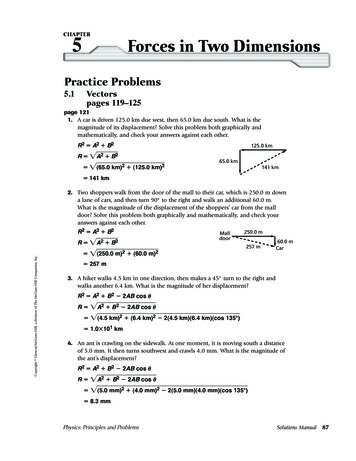
Transcription
CHAPTER5Forces in Two DimensionsPractice Problems5.1Vectorspages 119–125page 1211. A car is driven 125.0 km due west, then 65.0 km due south. What is themagnitude of its displacement? Solve this problem both graphically andmathematically, and check your answers against each other.R 2 ! A2 " B2R ! !"A2 " B2"! !(65.0km)2 "" (12"5.0 km")2""125.0 km65.0 km141 km! 141 km2. Two shoppers walk from the door of the mall to their car, which is 250.0 m downa lane of cars, and then turn 90 to the right and walk an additional 60.0 m.What is the magnitude of the displacement of the shoppers’ car from the malldoor? Solve this problem both graphically and mathematically, and check youranswers against each other.R 2 ! A2 " B2Copyright Glencoe/McGraw-Hill, a division of The McGraw-Hill Companies, Inc.R ! !"A2 " B2"!Malldoor(250.0"m)2 ""(60.0"m)2!"250.0 m257 m60.0 mCar! 257 m3. A hiker walks 4.5 km in one direction, then makes a 45 turn to the right andwalks another 6.4 km. What is the magnitude of her displacement?R 2 ! A2 " B 2 # 2AB cos !R!!2 " B"2 # 2A"B cos"!"!A(4.5 k"m)2 ""(6.4 k"m)2 #"2(4.5"km)(6".4 km)(cos"135 )"!"! 1.0 101 km4. An ant is crawling on the sidewalk. At one moment, it is moving south a distanceof 5.0 mm. It then turns southwest and crawls 4.0 mm. What is the magnitude ofthe ant’s displacement?R 2 ! A2 " B 2 # 2AB cos !R!!A2 " "B2 # "2AB c"os !!"2 ""mm)(4.0 m"m)2 #"2(5.0"mm)("4.0 mm)(cos 135 )"""""!(5.0! 8.3 mmPhysics: Principles and ProblemsSolutions Manual87
Chapter 5 continuedpage 125Solve problems 5–10 algebraically. You may also choose to solve some of them graphically tocheck your answers.5. Sudhir walks 0.40 km in a direction 60.0 west of north, then goes 0.50 km duewest. What is his displacement?Identify north and west as the positive directions.d1W ! d1 sin ! ! (0.40 km)(sin 60.0 ) ! 0.35 kmd1N ! d1 cos ! ! (0.40 km)(cos 60.0 ) ! 0.20 kmd2W ! 0.50 kmd2N ! 0.00 kmRW ! d1W " d2W ! 0.35 km " 0.50 km ! 0.85 kmRN ! d1N " d2N ! 0.20 km " 0.00 km ! 0.20 kmR!!2RN2"!RW ""(0.85 "km)2 ""(0.20"km)2!"! 0.87 km!R "RW! ! tan#1 !N! tan#1!!!"0.85 km0.20 km! 77 R ! 0.87 km at 77 west of northIdentify up and right as positive.FA on box,x ! FA on box cos !A! (20.4 N)(cos 120 ) Figure 5-6! #10.2 NFA on box,y ! FA on box sin !A! (20.4 N)(sin 120 )! 17.7 NFC on box,x ! FC on box cos !A! (17.7 N)(cos 55 )88Solutions ManualPhysics: Principles and ProblemsCopyright Glencoe/McGraw-Hill, a division of The McGraw-Hill Companies, Inc.6. Afua and Chrissy are going to sleepovernight in their tree house and areusing some ropes to pull up a boxcontaining their pillows and blankets,which have a total mass of 3.20 kg. Thegirls stand on different branches, as shownin Figure 5-6, and pull at the angles andwith the forces indicated. Find the x- andy-components of the net force on the box.Hint: Draw a free-body diagram so that you donot leave out a force.
Chapter 5 continued! 10.2 NFcombined ! Frope1 on swing cos ! "FC on box,y ! FC on box sin !AFrope2 on swing cos !! (17.7 N)(sin 55 )! 2Frope2 on swing cos !! 14.5 N! (2)(2.28 N)(cos 13.0 )Fg,x ! 0.0 N! 4.44 N upwardFg,y ! #mg! #(3.20 kg)(9.80 m/s2)! #31.4 N9. Could a vector ever be shorter than one ofits components? Equal in length to one ofits components? Explain.It could never be shorter than one of itscomponents, but if it lies along eitherthe x- or y-axis, then one of its components equals its length.Fnet on box,x ! FA on box,x "FC on box,x " Fg,x! #10.2 N " 10.2 N " 0.0 N! 0.0 NFnet on box,y ! FA on box,y "FC on box,y " Fg,y10. In a coordinate system in which the x-axis iseast, for what range of angles is the x-component positive? For what range is it negative?The x-component is positive for anglesless than 90 and for angles greaterthan 270 . It’s negative for anglesgreater than 90 but less than 270 .! 17.7 N " 14.5 N # 31.4 N! 0.8 NCopyright Glencoe/McGraw-Hill, a division of The McGraw-Hill Companies, Inc.The net force is 0.8 N in the upwarddirection.7. You first walk 8.0 km north from home, thenwalk east until your displacement from homeis 10.0 km. How far east did you walk?The resultant is 10.0 km. Using thePythagorean Theorem, the distance eastisR 2 ! A2 " B2, soB!!R2 # A"2!"(10.0 "km)2 "# (8.0"km)2!"! 6.0 km8. A child’s swing is held up by two ropes tiedto a tree branch that hangs 13.0 from thevertical. If the tension in each rope is 2.28 N,what is the combined force (magnitude anddirection) of the two ropes on the swing?Section Review5.1Vectorspages 119–125page 12511. Distance v. Displacement Is the distancethat you walk equal to the magnitude ofyour displacement? Give an example thatsupports your conclusion.Not necessarily. For example, you couldwalk around the block (one km perside). Your displacement would be zero,but the distance that you walk would be4 kilometers.12. Vector Difference Subtract vector K fromvector L, shown in Figure 5-7.The force will be straight up. Becausethe angles are equal, the horizontalforces will be equal and opposite andcancel out. The magnitude of thisvertical force isPhysics: Principles and ProblemsSolutions Manual89
Chapter 5 continued5.037.0 6.0L M#4.0KFigure 5-76.0 # (#4.0) ! 10.0 to the right16. Critical Thinking A box is moved throughone displacement and then through a second displacement. The magnitudes of thetwo displacements are unequal. Could thedisplacements have directions such that theresultant displacement is zero? Suppose thebox was moved through three displacements of unequal magnitude. Could theresultant displacement be zero? Supportyour conclusion with a diagram.No, but if there are threedisplacements, the sum canbe zero if the three vectorsform a triangle when theyare placed tip-to-tail. Also,the sum of three displacements can be zero withoutforming a triangle if the sum of twodisplacements in one direction equalsthe third in the opposite direction.13. Components Find the components ofvector M, shown in Figure 5-7.Mx ! m cos !! (5.0)(cos 37.0 )! 4.0 to the rightMy ! m sin !! (5.0)(sin 37.0 )! 3.0 upward14. Vector Sum Find the sum of the threevectors shown in Figure 5-7.Rx ! Kx " Lx " Mx! # 4.0 " 6.0 " 4.0! 6.0Ry ! Ky " Ly " My! 3.0R!!Rx2 ""Ry2!"2 ""3.02"!6.0! 6.7!R "Ry! ! tan#1 !!x! tan#1!!!"36! 27 R ! 6.7 at 27 15. Commutative Operations The order inwhich vectors are added does not matter.Mathematicians say that vector addition iscommutative. Which ordinary arithmeticoperations are commutative? Which are not?Addition and multiplication are commutative. Subtraction and division are not.90Solutions Manual5.2Frictionpages 126–130page 12817. A girl exerts a 36-N horizontal force as shepulls a 52-N sled across a cement sidewalkat constant speed. What is the coefficient ofkinetic friction between the sidewalk andthe metal sled runners? Ignore air resistance.FN ! mg ! 52 NSince the speed is constant, the frictionforce equals the force exerted by thegirl, 36 N.Ff ! !kFNFFNso !k ! !!f36 N! !!52 N! 0.6918. You need to move a 105-kg sofa to a different location in the room. It takes a force of102 N to start it moving. What is the coefficient of static friction between the sofa andthe carpet?Physics: Principles and ProblemsCopyright Glencoe/McGraw-Hill, a division of The McGraw-Hill Companies, Inc.! 0.0 " 0.0 " 3.0Practice Problems
Chapter 5 continuedFf ! !sFN5.8 N! !!F!s ! !fFN! 1.0 101 N0.58Ff, after ! !k, afterFNFf! !!mg! (0.06)(1.0 101 N)102 N! !!!2! 0.6 N(105 kg)(9.80 m/s )! 0.099119. Mr. Ames is dragging a box full of booksfrom his office to his car. The box andbooks together have a combined weight of134 N. If the coefficient of static frictionbetween the pavement and the box is 0.55,how hard must Mr. Ames push the box inorder to start it moving?FAmes on box ! Ffriction! !sFNFnet ! !kFNma ! !kmga!k ! !!g2! !smg1.25 m/s! !!2! (0.55)(134 N)! 0.128! 74 NCopyright Glencoe/McGraw-Hill, a division of The McGraw-Hill Companies, Inc.page 13022. A 1.4-kg block slides across a rough surfacesuch that it slows down with an accelerationof 1.25 m/s2. What is the coefficient ofkinetic friction between the block and thesurface?20. Suppose that the sled in problem 17 isresting on packed snow. The coefficient ofkinetic friction is now only 0.12. If a personweighing 650 N sits on the sled, what forceis needed to pull the sled across the snow atconstant speed?At constant speed, applied force equalsfriction force, soFf ! !kFN9.80 m/s23. You help your mom move a 41-kg bookcaseto a different place in the living room. Ifyou push with a force of 65 N and thebookcase accelerates at 0.12 m/s2, what isthe coefficient of kinetic friction betweenthe bookcase and the carpet?Fnet ! F # !kFN ! F # !kmg ! maF # ma!k ! !!mg65 N # (41 kg)(0.12 m/s2)(41 kg)(9.80 m/s )! (0.12)(52 N " 650 N)! !!!!2! 84 N! 0.1521. Suppose that a particular machine in afactory has two steel pieces that must rubagainst each other at a constant speed.Before either piece of steel has been treatedto reduce friction, the force necessary to getthem to perform properly is 5.8 N. After thepieces have been treated with oil, what willbe the required force?Ff, before ! !k, beforeFNFf,beforeso FN ! !!!k, beforePhysics: Principles and Problems24. A shuffleboard disk is accelerated to a speedof 5.8 m/s and released. If the coefficient ofkinetic friction between the disk and theconcrete court is 0.31, how far does the diskgo before it comes to a stop? The courts are15.8 m long.Identify the direction of the disk’s motionas positive. Find the acceleration of thedisk due to the force of friction.Fnet ! #!kFN ! #!kmg ! maa ! #!kgSolutions Manual91
Chapter 5 continuedThen use the equation vf2 ! vi2 "2a(df # di ) to find the distance.(0.0 m/s) # (23 m/s)2(2)(#0.41)(9.80 m/s )! !!!2Let di ! 0 and solve for df .vf2#2a! 66 m, so he hits the branch beforehe can stop.vi2df ! !!vf2 # vi2Section Review! !!(2)(#!kg)5.2(0.0 m/s)2 # (5.8 m/s)2(2)(#0.31)(9.80 m/s )! !!!2! 5.5 m25. Consider the force pushing the box inExample Problem 4. How long would ittake for the velocity of the box to double to2.0 m/s?The initial velocity is 1.0 m/s, the finalvelocity is 2.0 m/s, and the accelerationis 2.0 m/s2, sov #vf!i ; let ti ! 0 and solve for tf.a!!t #tfivf # vi!tf ! !a2.0 m/s # 1.0 m/s! !!!22.0 m/s! 0.50 sChoose positive direction as directionof car’s movement.Fnet ! #!kFN ! #!kmg ! ma28. Friction At a wedding reception, younotice a small boy who looks like his massis about 25 kg, running part way across thedance floor, then sliding on his knees untilhe stops. If the kinetic coefficient of frictionbetween the boy’s pants and the floor is0.15, what is the frictional force acting onhim as he slides?Ffriction ! !kFN! (0.15)(25 kg)(9.80 m/s2)vf2!vi22a(df # di ) to find the distance."! 37 N(2)(#!kg)29. Velocity Derek is playing cards with hisfriends, and it is his turn to deal. A card hasa mass of 2.3 g, and it slides 0.35 m alongthe table before it stops. If the coefficientof kinetic friction between the card and thetable is 0.24, what was the initial speed ofthe card as it left Derek’s hand?Solutions ManualPhysics: Principles and ProblemsLet di ! 0 and solve for df.v2#v22afi!df ! !vf2 # vi2! !!92They are similar in that they both act ina direction opposite to the motion (orintended motion) and they both resultfrom two surfaces rubbing against eachother. Both are dependent on the normalforce between these two surfaces. Staticfriction applies when there is no relativemotion between the two surfaces. Kineticfriction is the type of friction when thereis relative motion. The coefficient ofstatic friction between two surfaces isgreater than the coefficient of kinetic friction between those same two surfaces.! !kmga ! #!kgThen use the equationpage 13027. Friction In this section, you learned aboutstatic and kinetic friction. How are thesetwo types of friction similar? What are thedifferences between static and kinetic friction?Copyright Glencoe/McGraw-Hill, a division of The McGraw-Hill Companies, Inc.26. Ke Min is driving along on a rainy night at23 m/s when he sees a tree branch lyingacross the road and slams on the brakeswhen the branch is 60.0 m in front of him.If the coefficient of kinetic friction betweenthe car’s locked tires and the road is 0.41,will the car stop before hitting the branch?The car has a mass of 2400 kg.Frictionpages 126–130
Chapter 5 continuedIdentify the direction of the card’smovement as positive!kFN ! Fon table # maFnet ! #!kFN ! #!kmg ! ma!k ! !!Fon table # mamga ! #!kg25 N # (13 kg)(0.26 m/s)(13 kg)(9.80 m/s )! !!!2vf ! di ! 0 so! 0.17vi ! !#2ad"f"All you can conclude about the coefficient of static friction is that it isbetween! !#2(#!kg)df"""! !#2(#9.80 m"/s2)(0."35 m)"0.24)(""Fon table! 1.3 m/s!s ! !!mg30. Force The coefficient of static frictionbetween a 40.0-kg picnic table and theground below it is 0.43 m. What is thegreatest horizontal force that could beexerted on the table while it remainsstationary?20 N! !!!2(13 kg)(9.80 m/s )! 0.16Fon tableand !s ! !!mg25 N! !!!2Ff ! !sFN(13 kg)(9.80 m/s )! 0.20! !smg! (0.43)(40.0 kg)(9.80m/s2)Copyright Glencoe/McGraw-Hill, a division of The McGraw-Hill Companies, Inc.! 1.7 102 N31. Acceleration Ryan is moving to a newapartment and puts a dresser in the back ofhis pickup truck. When the truck acceleratesforward, what force accelerates the dresser?Under what circumstances could the dresserslide? In which direction?Friction between the dresser and thetruck accelerates the dresser forward.The dresser will slide backward if theforce accelerating it is greater than!smg.32. Critical Thinking You push a 13-kg tablein the cafeteria with a horizontal force of20 N, but it does not move. You then pushit with a horizontal force of 25 N, and itaccelerates at 0.26 m/s2. What, if anything,can you conclude about the coefficients ofstatic and kinetic friction?Practice Problems5.3Force and Motion inTwo Dimensionspages 131–135page 13333. An ant climbs at a steady speed up the sideof its anthill, which is inclined 30.0 fromthe vertical. Sketch a free-bo
mathematically, and check your answers against each other. R2! A2 " B2 R!!A"2 " B2!!(65.0" km)"2 "" (125.0 km")"2! 141 km 2. Two shoppers walk from the door of the mall to their car, which is 250.0 m down a lane of cars, and then turn 90 to the right and walk an additional 60.0 m. What is the magnitude of the displacement of the shoppers’ car from the mall door? Solve this problem both .
